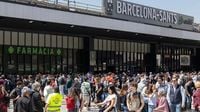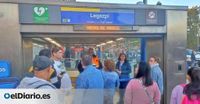Spain is grappling with the aftermath of a massive blackout that struck the nation on April 28, 2025, paralyzing transportation and leaving thousands stranded. The blackout, described as the largest in Spanish history, began at 12:30 PM when a "strong fluctuation of power flows" caused a complete collapse of the electrical grid. By 6:00 AM on April 29, Red Eléctrica reported that over 99% of the electricity supply had been restored, and all substations were back online.
Transportation services, however, faced significant disruptions. The Minister of Transportation, Óscar Puente, provided updates on the recovery of high-speed rail services, including connections from Madrid to Barcelona, Valencia, and the Basque Country. Despite efforts to restore normalcy, many train services remained suspended, particularly in Catalonia, where the Rodalies service was halted due to electrical instability.
In Madrid, the Cercanías commuter train service resumed at 5:00 AM, but with only 50% of its usual trains operating. The Metro de Madrid opened at 8:00 AM, with the exception of line 7A, and was set to run at 80% capacity during morning rush hour. Urban and interurban bus services were fully operational and free for the day, a move aimed at facilitating travel for those affected by the blackout.
Reports from various regions indicated that while electricity was gradually returning, the situation remained precarious. In the Comunidad Valenciana, over 99% of the power supply was restored, and the president of the region announced the deactivation of emergency protocols. Meanwhile, in Andalusia, 99.19% of the electric network was operational, although Almería was noted as the most affected province.
The blackout not only impacted transportation but also raised concerns about potential economic damages. Analysts warned that the incident could lead to losses of up to 4.5 billion euros in the Spanish GDP, particularly affecting businesses reliant on electrical power. The government has indicated that electric companies may need to compensate customers for outages exceeding three minutes.
As the day progressed, Madrid's streets reflected a mix of chaos and resilience. With traffic signals down and public transportation limited, many commuters resorted to walking or seeking rides. Reports indicated that the traffic situation was slightly lighter than usual, but major thoroughfares such as the A-2 and A-4 still experienced significant congestion.
In the early hours of April 29, emergency services were busy responding to incidents related to the blackout. The 112 emergency number opened nearly 5,000 cases, while firefighters conducted over 370 interventions. Fortunately, there were no major incidents reported, and the night in Catalonia remained calm despite ongoing power issues.
At the Santa Justa train station in Seville, travelers faced uncertainty as information panels remained off, and no trains were expected to depart until those stranded between Seville and Córdoba were cleared. Over 100 passengers spent the night at the station, waiting for updates on their travel plans.
In Madrid, public hospitals operated without power but maintained a level of precision and care, ensuring that emergency services were not compromised. Many residents found themselves carrying personal belongings and seeking alternative transportation, with some even resorting to hitchhiking.
As authorities worked to restore order, King Felipe VI presided over a National Security Council meeting to address the crisis. President Pedro Sánchez emphasized the government's commitment to investigating the cause of the blackout and managing the situation across the eight regions that declared a state of emergency.
While the situation was gradually improving, many were left wondering about the long-term implications of such a widespread failure. The blackout had disrupted not just daily life but also raised questions about the resilience of Spain's electrical infrastructure and the measures in place to prevent future incidents.
As the sun rose on April 29, Madrid began to stir back to life, with the iconic clock at Puerta del Sol having remained off during the night. Cafeteria San Ginés, a beloved local establishment, prepared to open its doors once again, while taxis and buses filled the streets, albeit with a sense of urgency and caution.
In the wake of the blackout, many residents expressed frustration and concern over the reliability of essential services. The government assured citizens that all resources were being mobilized to restore normalcy as quickly as possible, but the haunting memory of the blackout lingered in the minds of those affected.
As the day unfolded, the focus shifted to recovery efforts, with a clear message from officials: safety and stability were the priorities. The resilience of the Spanish people was evident as they navigated the challenges posed by the blackout, determined to return to their daily lives.
In summary, the blackout served as a stark reminder of the vulnerabilities in modern infrastructure, prompting discussions about the need for improvements and greater preparedness in the face of unforeseen events. With the immediate crisis subsiding, attention now turns to ensuring that such an incident does not happen again in the future.





